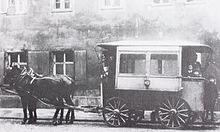Tram yard
| Tram yard | |||||||||||||||||||||||||||||||||||||||||||||||||||||||||||||||||||||||||||||||||||||
|---|---|---|---|---|---|---|---|---|---|---|---|---|---|---|---|---|---|---|---|---|---|---|---|---|---|---|---|---|---|---|---|---|---|---|---|---|---|---|---|---|---|---|---|---|---|---|---|---|---|---|---|---|---|---|---|---|---|---|---|---|---|---|---|---|---|---|---|---|---|---|---|---|---|---|---|---|---|---|---|---|---|---|---|---|---|
|
1907: Railcar 5 in the lower Ludwigstrasse
| |||||||||||||||||||||||||||||||||||||||||||||||||||||||||||||||||||||||||||||||||||||
| Route length: | 4.02 km of which passenger traffic: 3.12 km |
||||||||||||||||||||||||||||||||||||||||||||||||||||||||||||||||||||||||||||||||||||
| Gauge : | 1000 mm ( meter gauge ) | ||||||||||||||||||||||||||||||||||||||||||||||||||||||||||||||||||||||||||||||||||||
| Power system : | 500 volts = | ||||||||||||||||||||||||||||||||||||||||||||||||||||||||||||||||||||||||||||||||||||
| Top speed: | 18 km / h | ||||||||||||||||||||||||||||||||||||||||||||||||||||||||||||||||||||||||||||||||||||
|
|||||||||||||||||||||||||||||||||||||||||||||||||||||||||||||||||||||||||||||||||||||
The meter-gauge Hof tram ran between August 5, 1901 and November 14, 1921 in the Bavarian city of Hof from the main train station to the city center and on to the cemetery.
history
The builder and owner of the tram and the Hof power station, which was built in 1900, was Siemens & Halske ; the construction costs amounted to 391,911 Reichsmarks . The only line was electrically operated and connected the main train station, built in 1880 south of the city, with the city center and the new cemetery in the north on Plauener Strasse. It led via Bahnhofstrasse, Bismarckstrasse, Altstadt, Oberes Tor, Ludwigstrasse, Unteres Tor, Vorstadt and Schleizer Strasse to Plauener Strasse. The track was single track with Dodge in the Bismarck Street (corner Biengäßchen), the street Old Town on a sunny place and the suburbs to the Lower Gate. There were double-track stump ends at the main train station and at the cemetery . The depot was reached via a switch in Bismarckstrasse from the south on a 0.4 kilometer long service track through the Pfarr street. It was located on the former municipal utility area opposite today's Hofbad.
The tram replaced the horse-drawn bus , which ensured the connection between the main train station and the city between 1887 and 1901, but had difficulty coping with the gradient from the city to the train station. The average speed of the tram was ten kilometers per hour. She associated first in a ten-minute cycle to the Lower Stone Bridge, the cemetery was only moved on when at least five passengers wished. From 1909 to the First World War , the timetable was reduced to eight minutes. The operation took place without a conductor , passengers over four years of age dropped the standard fare of ten pfennigs in a payment box at the driver's premises .
After operations had ceased for financial reasons on January 20, 1920, the tram was contractually transferred to the city of Hof on August 1, 1920, which resumed operations to a very limited extent.
During the period of inflation, tram operations were "temporarily" suspended on November 14, 1922 because fares did not keep pace with inflation. There was no resumption of traffic; instead, from 1925, the main train station was connected to the city center by bus and coach lines. The tracks were removed from the streets in the early 1930s.
The license to operate the line has not expired to this day.
vehicles
The Hof tram had seven two-axle railcars with open platforms, they had the road numbers 1 to 7. Manufacturer was the Hannoversche Waggonfabrik (HAWA), the electrical equipment was supplied by Siemens & Halske. The cars, powered by 500 volts direct current, were equipped with two 10.5 kilowatt electric motors and reached a top speed of 20 kilometers per hour. Each car offered 16 seats and 14 standing places. Sidecars were not in use. The front of the vehicles was painted ivory with black decorative stripes, the side walls of the railcars were black and the roof was gray.
After the preliminary cessation of operations, the railcars were parked in the depot. In the 1930s and 1940s they were sold as gazebos. In addition, there were two work vehicles known as “special vehicles” during the operating period. Almost all the vehicles in the Hof tram have now been scrapped, only one railcar has been preserved and serves as a garden shed in a Hof garden.
See also
literature
- Arnd Kluge : History and stories - walks through Hof's past Walk 1: With the tram through Alt-Hof
- Hofer Heimatbuch - Guide to the Bavarian Vogtland Museum . Publishing house of the Northeast Upper Franconian Association for Nature, History and Regional Studies Hof, Hof (Saale) 1996
- Dieter Höltge: German trams and light rail vehicles. Volume 1: Bavaria . Wolfgang Zeunert, Gifhorn 1977, ISBN 3-921237-33-5 , p. 44-49 .
- Dieter Höltge, Michael Kochems: Trams and light rail vehicles in Germany. Volume 10: Bavaria . EK-Verlag, Freiburg 2006, ISBN 978-3-88255-391-8 , p. 67-81 .
Web links
- www.hof.de - Information from the city of Hof about the Hof tram
Individual evidence
- ^ Dieter Höltge: German trams and city railways. Volume 1: Bavaria . Wolfgang Zeunert, Gifhorn 1977, ISBN 3-921237-33-5 , p. 45 .
- ^ Günther Klebes: The trams of Bavaria in old views, ISBN 90-288-1197-4
- ↑ a b Dieter Höltge, p. 47
- ↑ Dieter Höltge, p. 49


